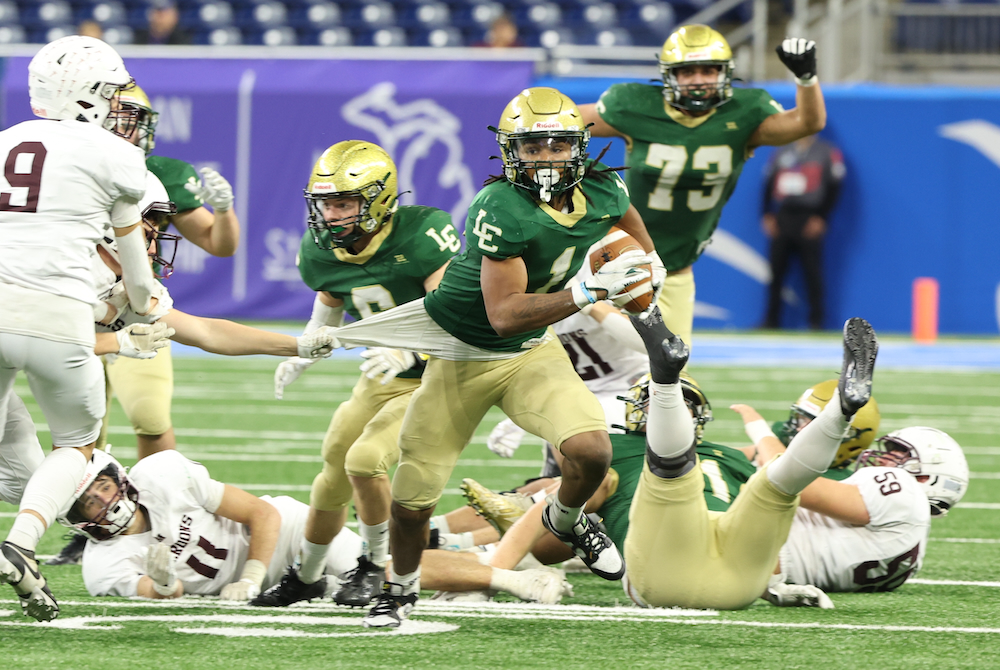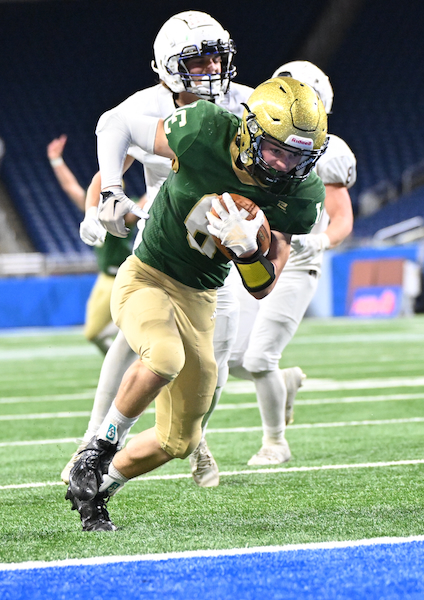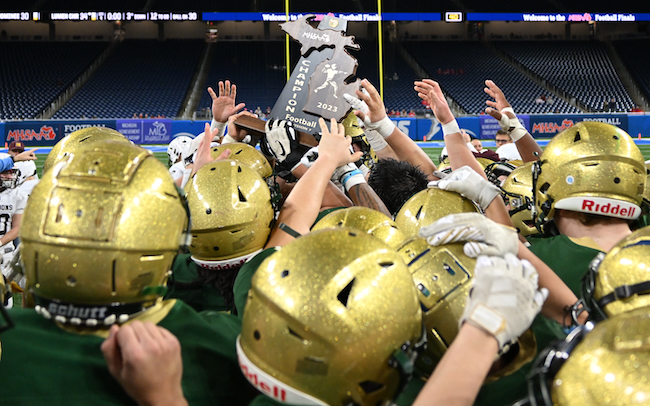
Inside Selection Sunday: Mapnalysis '13
October 28, 2013
By Geoff Kimmerly
Second Half editor
At the end of the day – Sunday, in this case – the 2013 MHSAA football playoff field was determined based on a set of numbers we began working with long before the first kickoff of this season.
So to kick off our discussion of how some of the 2013 playoff-selection decisions were made, here are a few numbers that might boggle the mind – or at least surprise:
- A total of 3,111 high school results were used in determining this season’s field – 2,978 for 11-player and 133 for 8-player games.
- We inputted and then followed the schedules for 623 MHSAA teams.
- We also inputted and followed weekly the schedules for 50 teams from surrounding states and Ontario that played at least one game against one of our MHSAA schools.
- We worked through complicated maneuverings made necessary by seven teams playing a mix of 11 and 8-player games, plus two more teams that played a mix of varsity and junior varsity opponents.
- And by Sunday morning we ended up with a few more numeric rarities: only 225 automatic qualifiers, the fewest since the current playoff system was introduced in 1999, and also an uneven number of at-large bids from our four classes because only six Class D teams reached the number of victories needed to be considered. (This was balanced by taking more at-large qualifiers from Classes A, B and C.)
And that was just the start of one of our most exciting days of the school year.
Following are more details. First, I explain some of the history of the MHSAA playoffs – I’ve lifted this in part from our 2012 report, so skip ahead if you’ve already got that down. Next, I touch on five themes that emerged as we built the brackets for this season’s tournament.
The process
Our past: The MHSAA playoff structure – with 256 teams in eight divisions, and six wins equaling an automatic berth (or five wins for teams playing eight or fewer games) – debuted in 1999, as mentioned above. An 8-player tournament was added in 2011, resulting in nine champions total when November is done.
That’s a long way from our start. The first playoffs were conducted in 1975 with four champions. Four more football classes were added in 1990 for a total of eight champions each fall. Through 1998, only 128 teams made the postseason, based on their playoff point averages within regions (four for each class) that were drawn before the beginning of the season. The drawing of Districts and Regions after the end of the regular season did not begin until the most recent playoff expansion.
In early years of the current process (or until the middle of the last decade), lines were drawn by hand. Dots representing qualifying schools were pasted on maps, one map for each division, and those maps were then covered by plastic sheets. Districts and Regionals literally were drawn with dry-erase markers.
Our present: After a late Saturday night tracking scores, we file in as the sun rises Sunday morning for a final round of gathering results we may still need (which can include making a few early a.m. calls to athletic directors). Then comes re-checking and triple-checking of enrollments, what schools played in co-ops, some records and more before the numbers are crunched and the fields are set.
Those 256 11-player teams are then split into eight equal divisions based on enrollment, and their locations are marked on digital maps that are projected on wall-size screens and then discussed by nearly half of the MHSAA staff plus a representative from the Michigan High School Football Coaches Association. Only the locations themselves are marked (by yellow dots) – not records, playoff point averages or names of the schools or towns. In fact, mentions of those are strictly prohibited. Records and playoff points are not part of the criteria. Matchups, rivalries, previous playoff pairings, etc. also DO NOT come into play. The same process is followed for organizing the 8-player bracket.
Observations and answers: 2013
This doesn’t happen overnight: Preparation for selecting the MHSAA playoff field begins long before the first kickoff of fall, much less the first practice. We load schedules for all 600-plus varsity teams during the summer, and many schedules remain fluid right up until the first Friday of the season – and this fall, a few weren’t settled until Week 2 or 3.
This summer as in some past we also worked through schools closing (Inkster, Saginaw Buena Vista, Detroit Northwestern, Flint Northern), and others deciding in mid-July and early August they would not field teams because of a lack of players.
Sometimes we have to take odd paths to find scores for these games. The last 11-player score to be added to our data this regular season came in as a result of tweeting the sports anchor of a Wheeling, W.Va., television station. Our last 8-player score came in via email from a Wisconsin athletic director at 10:30 Saturday night. Thankfully, we get plenty of assistance from some of our friends in the field, who keep an eye on the data and alert us when something appears missing or incorrect.
Win and advance: This season’s list of 5-4 teams includes a number of heavy hitters that did not receive at-large bids – East Grand Rapids, Utica Eisenhower, Orchard Lake St. Mary’s and Flint Powers Catholic to name a few. All were solid teams and played strong competition. All missing the playoffs likely raised some eyebrows.
But we have to take a look at this from a statewide view. There admittedly can be some argument about what schools qualified for the 226-256 spots in the field – but the important part is that 225 qualified because they all met the minimum win requirement. A playoff is simply that – it decides a champion based on teams winning. For some it’s harder to pile wins, of course, because they play in tough leagues. But the winners of those leagues are in the field – and surely will credit that tough road with getting them prepared to now play the state’s best.
Geography rules: This long has been rule number one for drawing MHSAA brackets in any sport, and is a repeat as well for those who have read this report the last two Octobers. Travel distance and ease DO come into play. Jumping on a major highway clearly is easier than driving across county-wide back roads, and that’s taken into consideration.
Also, remember there’s only one Mackinac Bridge and hence only one way to cross between peninsulas – and boats are not considered a possible form of transportation. When opponents from both peninsulas will be in the same District, distance to the bridge is far more important than as the crow flies.
The best example of this comes this season in Division 5. Grayling clearly is east of both Kingsley and Kalkaska – but also sits on I-75, while those two do not. So while those more western teams are geographically closer to Houghton, Menominee and Kingsford from the Upper Peninsula, we instead paired the three U.P. teams with Grayling because being on a main highway made for a shorter trip. The trip to Grayling for any of those U.P. teams would be 36 miles shorter to Grayling than Kingsley and 13 miles shorter to Grayling than Kalkaska.
Sometimes it’s where the points aren’t: Sure, it would be best-case scenario to have perfect sets of eight dots split into four quadrants from Calumet to Bedford. But generally that doesn’t occur. “Dots determine the map” is a common phrase heard here during this selection process, but that works the other way as well. If there are no qualifiers in a division from a specific area of the state – see Division 1, with none south of Holland or west of the greater Lansing area – there’s no choice but to create the unusual Regional Final possibility of Traverse City West vs. Brighton. Brighton is simply closer to the west side of the state than our other options.
Border to border vs. coast to coast: Should Regions be grouped north to south or east to west? There isn't a right or wrong answer – it just depends on that set of dots.
Whenever we have Upper Peninsula teams in a division, they’ll be grouped with those from the northernmost points of the Lower Peninsula for a District. The next northernmost schools will be grouped into a District, and together those eight will form a Region.
But the tough decision comes with the other six Districts. Look at this season’s Division 5 map: Six Districts are grouped south of U.S. 10 with three near or west of U.S. 127 and three east of that highway, which runs through the center of the Lower Peninsula. We grouped the two southwestern Districts into a Region and the two southeastern Districts into a Region – leaving a final Region that stretches from Muskegon on Lake Michigan to Almont, about 35 miles west of Lake Huron.
That’s a haul. But it’s also the best of our possible compromises. We could’ve instead paired regions that would’ve stretched from Hopkins to Monroe – only 19 fewer miles in distance than Muskegon Oakridge to Almont, but a scenario that could’ve created travel increases for a number of additional teams. Another option included a possible trip from Detroit University Prep to Freeland, which also would take more than two hours.
Bottom line – it’s been written here before – we pour all we have into this process, asking questions often more than once until we come up with a consensus. We do appreciate the arguments that arise once brackets are released to the public: The discussions are proof of how much players, coaches and fans care – and often show us new ways we can look at a system that’s now 15 years old.
But we must remember that the good news is the tournament is still set up to reward nine champions over the next five weeks, and five schools – Auburn Hills Oakland Christian, Coldwater, Detroit Allen, Eaton Rapids and Muskegon Mona Shores – will be competing for those titles for the first time.
It’s not so much how the tournament starts as how it ends. And we’re preparing for nine more memorable conclusions.
PHOTO: Each collection of grouped dots is a District on this season's Division 3 playoff map.

Lumen Christi Answers Early Deficit, Scores Game-Winner Late to Earn Record-Tying Title
By
Tom Kendra
Special for MHSAA.com
November 26, 2023
DETROIT - Jackson Lumen Christi piled up 92 percent of its total yards Sunday morning on the ground.
So, trailing by three points with time running down in the fourth quarter and facing a 4th-and-4 situation on the Menominee 11-yard line, the Titans, of course, went to the air.
“It was a play we put in this week, and we (practiced) it over and over,” explained Lumen Christi junior quarterback Timmy Crowley. “Actually, it goes back to the summer and the connection that I developed with Gabe (King).”
Crowley delivered a strike to King on the sideline near the goal line, and King then spun into the end zone for the game-winning score with 4:04 remaining in an eventual 34-30 victory over upset-minded Menominee in a Division 7 title game shootout at Ford Field.
Menominee (11-3) had one final chance, driving into Lumen Christi territory, before senior quarterback Trevor Theuerkauf was hauled down from behind by freshman Lundon Hampton on fourth down to seal the win.
“It was an entertaining game, for sure,” said 44th-year Lumen Christi coach Herb Brogan, who was frustrated by some of his team’s blown coverages. “I like the way that we answered, time and time again.”
 Lumen Christi (13-1) won its second consecutive Division 7 title, its fifth championship over the past eight years and 13th overall – 11th under Brogan – moving the program into a tie with Farmington Hills Harrison for the most football titles in MHSAA history.
Lumen Christi (13-1) won its second consecutive Division 7 title, its fifth championship over the past eight years and 13th overall – 11th under Brogan – moving the program into a tie with Farmington Hills Harrison for the most football titles in MHSAA history.
It didn’t look good early for the Titans, as the Maroons used a 2-yard run by Landan Barkowski and a 34-yard pass from Theuerkauf to tight end Eli Beal to take a stunning 14-0 lead by the end of the first quarter.
The Titans settled down in the second quarter and fought back behind the speed, power and tackle-breaking ability of junior running back Kadale Williams (6-foot-1, 180 pounds), who finished with 27 carries for 276 yards and three touchdowns.
“It starts with the guys up front,” explained Williams, who rarely went down without multiple Maroons clutching onto him. “Once they do their jobs and create a gap, I owe it to them to make a play every time.”
Williams broke loose on TD runs of 1 and 45 yards during the second quarter, making the score 14-14 at halftime.
That set the stage for a classic back-and-forth second half, with both teams refusing to lose.
Menominee, a perennial power for years behind its tightly-packed, single-wing offense, showed off its offensive evolution under second-year coach Chad Brandt, who has incorporated elements of the spread. The Maroons kept the Titans guessing with a balanced attack, passing for 199 yards and rushing for 143.
“We were able to run and throw to keep them off balance, which is what we have been doing all year,” said Brandt, who was head coach at Stephenson in the Upper Peninsula for 20 years before coming to Menominee as an assistant coach in 2018. “We saw the predictions, but our kids are resilient. We were able to display our skills and just came up one play short.”
Lumen Christi stuck almost exclusively to the ground, with 351 rushing yards and 29 passing yards, scoring in the third quarter on a 1-yard run by Crowley and then early in the fourth quarter on a 3-yard run by Williams.
Each time the Titans took the lead in the second half and appeared poised to take control, the Maroons struck back, first on a 21-yard scoring scramble by Theuerkauf and then a 76-yard pass from Theuerkauf to Isaiah Odom, which gave them a 30-27 lead in the fourth quarter.
Then came the game-winning drive, as the Titans went 61 yards in 10 plays, culminating with the game-winning, 11-yard pass from Crowley to King.
Menominee was surely keying on Williams by that point in the game, which set up the winning play-action pass.
“I think we wear people down up front,” said Brogan, who took over the Lumen Christi program in 1980 after the death of Jim Crowley, who guided the Titans to their first two titles in 1977 and 1979. “When you do that and create seams, Kadale is going to make plays.”
 The Titans started four juniors up front in guards Andrew Salazar and Maverick Stergakos, center Drew Sweeney and tight end Charlie Saunders. The only senior starters on the offensive line were tackles Aiden Pastoriza and Luke Smith.
The Titans started four juniors up front in guards Andrew Salazar and Maverick Stergakos, center Drew Sweeney and tight end Charlie Saunders. The only senior starters on the offensive line were tackles Aiden Pastoriza and Luke Smith.
Both teams performed admirably on the big Ford Field stage, with just six total penalties and no turnovers.
Theuerkauf (5-11, 175) was all over the field during his final prep game, starting at his safety spot with a game-high 17 tackles (10 solos). He completed 9-of-22 passes for 199 yards and rushed 15 times for 84 yards.
Eli Beal made four catches for 63 yards and Tanner Theuerkauf, Trevor’s sophomore brother, had two catches for 42 yards. Blake Paasch made six tackles, and Beal and Tanner Theuerkauf each had five stops.
Both Crowley and Williams return next season for Lumen Christi, and their goal is to break the record for Finals wins.
“It’s so much fun handing the ball off to (Williams) and watching him run,” said Crowley, who finished 2-of-6 passing for 29 yards. “It means a lot with our tradition to win it, but I want to get back here next year and do it again.”
Isaac Rehberg carried seven times for 49 yards for Lumen Christi, while Josh Dumont and Ryan Walicki led the defense with eight tackles apiece.
PHOTOS (Top) Kadale Williams (1) pulls aways from a defender during Jackson Lumen Christi’s Division 7 win Sunday morning. (Middle) The Titans’ Gabe King leans into his fourth-quarter score. (Below) Lumen Christi raises its latest championship trophy at Ford Field. (Photos by Hockey Weekly Action Photos.)

